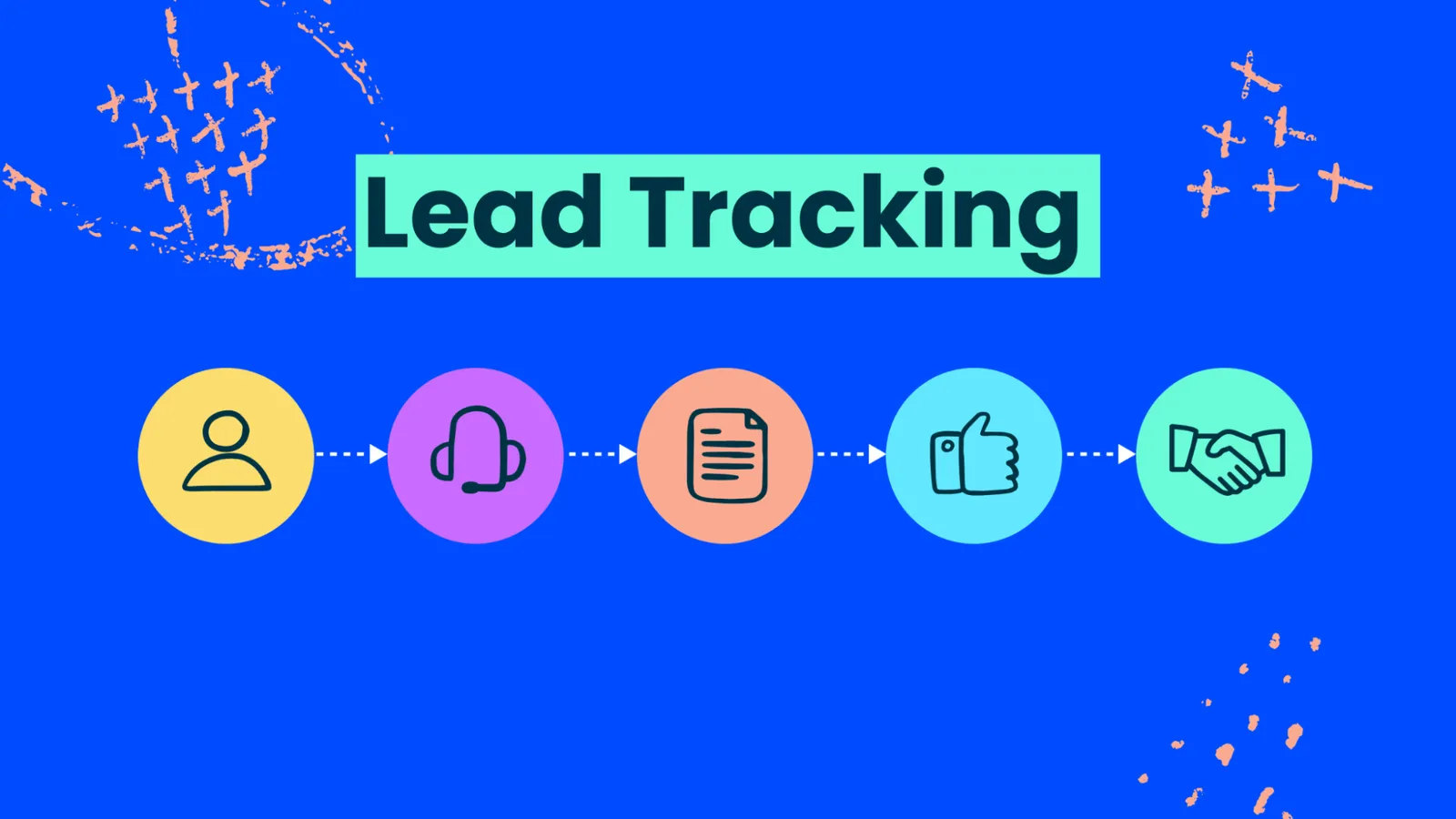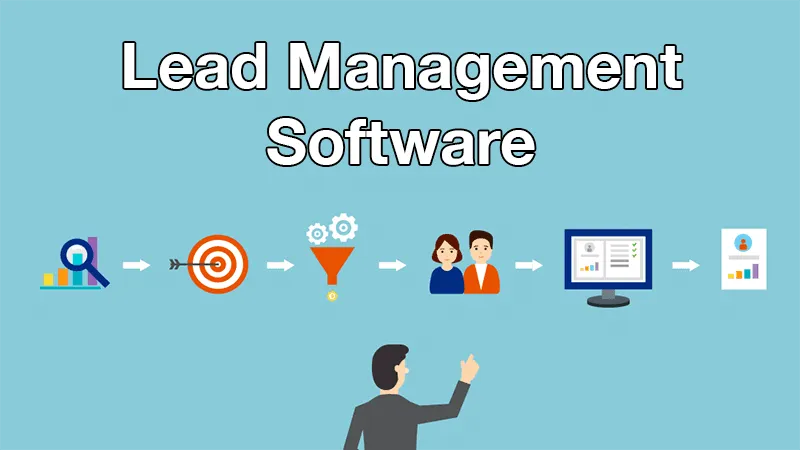Tracking sales leads effectively makes all the difference between a sales team that closes deals and one that loses potential customers. Without a structured sales process, businesses risk missing out on qualified leads that could turn into paying customers.
According to HubSpot, 63% of businesses say generating leads is their biggest challenge, highlighting the need for better organization. A well-managed sales lead database helps streamline follow-ups, nurture relationships, and increase conversions.
In this guide, you’ll learn six simple steps to organize and track your sales leads for better results.
What Are Sales Leads?

Sales leads are potential customers who have shown interest in a company's products or services. They come from various sources like social media, email marketing, and networking events. Businesses use lead scoring to determine whether they are qualified leads or just cold leads.
A well-structured crm system helps in tracking sales lead generation efforts and managing lead nurturing effectively. Companies analyze market research, website visits, and social media interactions to identify the right leads.
Using marketing automation, businesses can engage with potential buyers and improve their conversion rates. A strong sales funnel ensures efficient lead management for better results.
Why Is It Important to Manage Sales Leads Efficiently?

1. Prevent Lost Opportunities
Without a structured sales process, businesses struggle to track potential deals. A lack of lead generation efforts can result in missing out on quality leads.
Using advanced search filters and maintaining updated business contacts helps prevent losing valuable prospects.
2. Increase Sales Team Productivity
An organized approach helps sales reps focus on high quality leads instead of wasting time on unqualified ones. Tools like marketing automation and content marketing strategy streamline lead tracking.
A well-maintained sales force ensures better coordination between marketing teams and sales professionals.
3. Improve Lead Qualification
Not every prospect is ready to buy. Separating marketing qualified leads from hot leads improves conversion chances.
Businesses can use lead scoring and intent data to prioritize the most promising relevant prospects.
4. Speed Up the Sales Process
A structured system ensures leads move quickly through the sales cycle. Businesses can automate follow-ups using direct messaging and track performance with click-through rates. This approach helps small businesses and new businesses compete effectively.
5. Strengthen Customer Relationships
Long-term success depends on nurturing repeat customers and engaging with existing customers.
Tracking customer interactions through trade shows or social media platforms improves retention. A focus on valuable content builds trust.
6. Use Data to Optimize Sales
Using data enrichment and monitoring track metrics provides insights into buyer behavior.
Businesses can refine their strategy by analyzing landing pages, buyer personas, and more data. Implementing cost-effective lead management improves efficiency and results.
Efficient lead management ensures businesses find sales leads nurture potential buyers, and close more deals with minimal effort.
“Tired of losing sales leads? Let Alore automate your lead tracking and follow-ups for seamless conversions.”
How to Generate Sales Leads the Right Way?

1. Define Your Target Audience
Understanding the target audience is the first step in lead generation efforts. Without knowing who your potential leads are, it’s difficult to create a strategy that works. Identifying the ideal customer ensures that businesses attract people who are more likely to become paying customers.
How to Do It:
- Research your target audience using market research and customer data.
- Analyze social media interactions to understand preferences.
- Segment leads based on interests, demographics, and needs.
- Identify potential buyers who are actively looking for solutions.
2. Use Multiple Lead Sources
Relying on a single method to find sales leads can limit opportunities. Businesses should explore different types of sales leads, including cold leads, warm leads, and referrals. Using various lead sources improves chances of reaching the right decision makers.How to Do It:
- Attend trade shows and networking events to connect with prospects.
- Use outreach efforts like direct engagement and relationship-building.
- Utilize data enrichment tools to refine lead lists.
- Leverage social media platforms to expand reach.
3. Leverage Content Marketing
Sharing valuable information helps businesses attract potential leads. A strong content marketing strategy builds credibility and keeps new leads engaged. Providing insights through blogs, whitepapers, and case studies encourages expressed interest from prospects.
How to Do It:
- Create high-quality content based on market research and customer needs.
- Offer free guides or reports to generate marketing qualified leads.
- Optimize content with SEO strategies to attract potential customers.
- Share insights on social media platforms to reach a broader audience.
4. Optimize Your Website
A well-structured website plays a crucial role in lead generation efforts. Visitors who land on a website should easily find the information they need, making them more likely to convert into qualified leads. Landing pages with clear calls-to-action improve engagement.
How to Do It:
- Ensure fast loading times and easy navigation.
- Use custom pricing pages to attract business to business leads.
- Optimize contact forms to collect contact details efficiently.
- Track website visits to analyze lead behavior.
5. Engage on Social Media
Interacting with prospects on social media is an effective way to generate interest. Businesses can reach new customers by sharing relevant content and participating in discussions. Monitoring social media interactions helps in identifying more sales opportunities.
How to Do It:
- Post consistently on platforms where your potential customers are active.
- Use targeted outreach to engage with relevant prospects.
- Leverage paid advertising on social media platforms for better visibility.
- Track engagement metrics to refine your approach.
6. Run Effective Email Outreach
Email remains one of the most reliable ways to generate sales and nurture leads. A well-structured email strategy helps in converting business contacts into paying customers. Personalizing emails ensures higher engagement.
How to Do It:
- Build an email list with verified contact details.
- Segment cold leads and warm leads for personalized outreach.
- Offer value-driven content in emails to encourage expressed interest.
- Monitor click-through rates to track email effectiveness.
A combination of these strategies ensures businesses can find sales leads, engage with potential buyers, and improve lead conversion rates effectively.
“Want to scale your outreach? Alore’s Drip Campaigner automates email sequences, ensuring you reach leads at the right time.”
What’s the Best Way to Identify Qualified Leads?

1. Define Lead Criteria
Before engaging with potential customers, businesses need clear lead criteria. This helps filter out unqualified prospects and focus on those with real intent. A well-defined approach ensures resources are used efficiently and the right customers are targeted.
Steps to Do It:
- Outline key characteristics based on marketing efforts and past data.
- Identify pain points and needs that match your company's products.
- Use demographic and behavioral data to refine your list.
2. Use Lead Scoring
Not all leads are equal. Lead scoring assigns a value to each prospect based on their likelihood to convert. This process prioritizes leads, ensuring sales teams focus on high-value opportunities.
Steps to Do It:
- Assign points based on interactions like email responses and website visits.
- Use automation tools that integrate enhanced targeting for scoring accuracy.
- Adjust lead scores based on shown interest in your offerings.
3. Analyze Engagement
Tracking how leads interact with content and marketing efforts gives insight into their intent. Businesses that analyze engagement data can fine-tune their approach and improve conversions.
Steps to Do It:
- Monitor clicks, form submissions, and session times on landing pages.
- Compare engagement across different marketing materials to see what works.
- Identify drop-off points and optimize the customer journey.
4. Separate MQLs and SQLs
Marketing Qualified Leads (MQLs) and Sales Qualified Leads (SQLs) serve different purposes. MQLs need further nurturing, while SQLs are ready for direct sales engagement. Properly categorizing leads avoids wasted efforts.
Steps to Do It:
- Use lead behavior analysis to classify buying leads accurately.
- Ensure MQLs meet the minimum interest threshold before moving to SQL status.
- Align sales and marketing teams for seamless lead transitions.
5. Verify Contact Details
Incorrect or outdated contact information leads to wasted sales efforts. Businesses should validate details before proceeding with outreach.
Steps to Do It:
- Implement human verification for all incoming leads.
- Cross-check email addresses and phone numbers for accuracy.
- Use AI-based verification tools for large lead lists.
6. Assess Budget and Timeline
A lead's readiness to buy depends on budget and urgency. Understanding these factors prevents chasing leads that aren’t a good fit.
Steps to Do It:
- Ask qualifying questions to determine if leads have the budget to proceed.
- Identify decision-makers in companies through local chamber networks.
- Segment leads based on purchasing timelines and business goals.
Properly identifying qualified leads improves efficiency, prevents wasted resources, and helps businesses engage with prospects at the right time.
How to Organize and Track Sales Leads for Better Conversions?

1. Prioritize Leads
Not all leads are equal. Some are ready to buy, while others need more time and nurturing. Prioritizing sales leads ensures the sales team focuses on high-value opportunities. Leads should be categorized based on engagement, interest, and potential to convert.
How to Prioritize Leads
- Segment leads into hot, warm, and cold categories.
- Use lead scoring to rank leads based on engagement and interactions.
- Focus on high-value leads with a greater chance of converting.
2. Use a CRM
A CRM system helps organize leads, track interactions, and manage follow-ups in one place. It provides real-time insights into lead status, helping teams work more efficiently. Without a CRM, tracking conversations and progress can become chaotic.
How to Use a CRM
- Store lead details, interactions, and notes in one place.
- Automate task reminders for timely follow-ups.
- Use CRM analytics to monitor lead movement through the sales process.
3. Automate Follow-Ups
Following up with leads is crucial, but doing it manually can be time-consuming. Automation ensures no lead is forgotten and follow-ups happen at the right time.
How to Automate Follow-Ups
- Set up email sequences for different lead stages.
- Use CRM reminders for scheduled calls and meetings.
- Automate responses for frequently asked questions.
4. Update Lead Data
Leads change over time—job roles shift, contact details get updated, and priorities evolve. Keeping lead data current prevents wasted efforts on outdated information.
How to Update Lead Data
- Regularly verify contact information and company details.
- Remove inactive leads or update their status in the CRM.
- Use data enrichment tools to keep information accurate.
5. Assign Leads Smartly
Assigning leads to the right sales team members increases the chances of conversion. A structured assignment process prevents confusion and ensures every lead gets proper attention.
How to Assign Leads
- Distribute leads based on expertise and past performance.
- Rotate leads fairly to balance workloads.
- Assign high-priority leads to experienced team members.
6. Track and Adjust
Tracking lead progress helps identify what’s working and what needs improvement. Analyzing lead performance allows teams to refine their approach for better results.
How to Track and Adjust
- Monitor key metrics like response rates and conversion timelines.
- Analyze trends to improve lead nurturing strategies.
- Adjust follow-up frequency based on lead engagement.
Organizing and tracking sales leads properly leads to better efficiency, higher conversions, and stronger relationships with potential customers.
How to Set Up an Effective Sales Lead Management System?

A sales lead management system helps businesses track and organize leads efficiently. Without a structured approach, potential customers can slip through the cracks, leading to missed opportunities. The first step is identifying lead sources like social media, website inquiries, referrals, and outbound efforts. Categorizing leads based on their origin helps streamline the tracking process.
Using the right tools is essential for managing leads effectively. A CRM system stores contact details, interactions, and follow-up schedules in one place. Integrating marketing automation tools ensures timely follow-ups and prevents leads from going cold.
Businesses should also set clear criteria to determine qualified leads, distinguishing between marketing qualified leads (MQLs) and sales qualified leads (SQLs) to focus efforts on high-potential prospects.
Once leads are qualified, they should be assigned to the right sales team members for follow-up. Proper distribution ensures leads receive timely attention, increasing the chances of conversion. Tracking lead progress and analyzing data regularly helps refine strategies for better results. A well-structured sales lead management system improves efficiency, keeps sales organized, and drives better customer engagement.
How to Optimize Your Sales Process for Seamless Lead Tracking?

1. Map Out Your Sales Process
A clear sales process helps track leads at every stage. Without a structured approach, businesses may struggle to know where leads stand and what actions to take next. Mapping out each step, from initial contact to conversion, ensures consistency and better organization.
2. Eliminate Bottlenecks
Delays in the sales process can cause leads to lose interest. Identifying where bottlenecks occur, such as slow response times or lengthy approval processes, helps in making necessary improvements. Simplifying steps and reducing unnecessary tasks ensures a smoother experience for both the sales team and potential customers.
3. Automate Lead Management
Manually tracking leads can be time-consuming and inefficient. Using automation tools helps manage follow-ups, update lead status, and send timely reminders without manual effort. A CRM system with automation features ensures that no lead is forgotten, improving overall efficiency.
4. Align Sales and Marketing Teams
Effective lead tracking requires strong collaboration between sales and marketing teams. If marketing generates leads but sales teams don’t have the right information, opportunities can be missed. Keeping both teams aligned ensures that qualified leads are properly nurtured and followed up.
5. Set Clear Follow-Up Schedules
Following up at the right time increases the chances of conversion. Leads often need multiple interactions before making a decision, so having a structured follow-up schedule prevents missed opportunities. Setting reminders for calls, emails, and check-ins keeps engagement consistent.
6. Track and Improve Performance
Continuous tracking helps refine the sales process for better results. Monitoring key metrics like response rates, conversion timelines, and follow-up success rates helps identify areas for improvement. Adjusting strategies based on performance data ensures a more effective approach to lead management.
Optimizing the sales process makes lead tracking more efficient, helping businesses engage with leads effectively and improve overall conversion rates.
How Can Your Sales Team Improve Lead Organization?

A well-organized sales team ensures that no lead is lost or neglected. The first step is to categorize sales leads based on their stage in the sales process—hot, warm, or cold. This helps in prioritizing follow-ups and focusing on qualified leads.
Using a CRM system makes tracking easier by storing all lead details in one place. Automating routine tasks, such as follow-up reminders and data entry, reduces manual effort and keeps lead information updated. Regularly reviewing and refining lead organization strategies ensures that the sales team stays efficient and improves conversion rates.
What’s the Best Way to Nurture and Convert Leads Efficiently?
- Engage Leads Consistently – Follow up regularly with personalized communication to keep leads interested.
- Use a Lead Nurturing Strategy – Guide leads through the sales process with relevant content, emails, and calls.
- Personalize Communication – Tailor messages based on lead behavior, interests, and past interactions.
- Provide Value at Every Step – Answer questions, share helpful resources, and address concerns.
- Follow Up at the Right Time – Schedule timely check-ins without being too aggressive.
- Automate Follow-Ups – Use email sequences and CRM reminders to ensure no lead is missed.
- Track Lead Engagement – Monitor website visits, email opens, and responses to gauge interest.
- Maintain Relationships Post-Sale – Continue providing support and value to encourage repeat business and referrals.
A structured lead nurturing approach helps turn potential customers into long-term clients, improving overall sales performance.
“Don’t let leads slip away! Let Alore’s AI-driven tracking, automation, and analytics transform your sales process.”
Conclusion
Organizing and tracking sales leads doesn’t have to be complicated. By prioritizing leads, using a CRM system, and setting up structured follow-ups, businesses can stay on top of every opportunity.
A well-managed sales process helps the sales team focus on qualified leads while reducing wasted efforts. Small changes, like keeping lead data updated and automating routine tasks, can make a big difference.
The key is consistency, staying engaged with leads, tracking progress, and refining strategies along the way. With the right approach, businesses can turn potential customers into long-term clients and improve sales results over time.

.webp)







